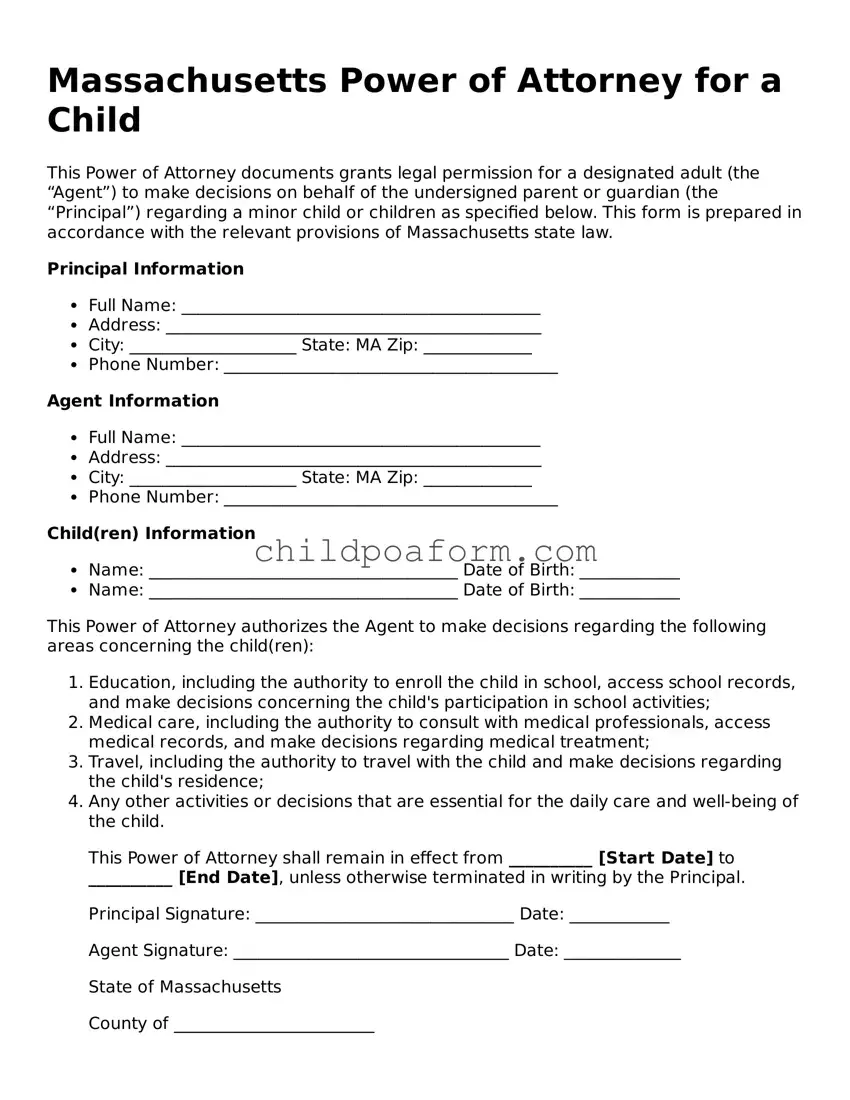Instructions on Utilizing Massachusetts Power of Attorney for a Child
When a parent or guardian is unable to be present for a period due to travel, illness, or other reasons, they can use a Power of Attorney for a Child form in Massachusetts. This legal document grants an appointed person the authority to make decisions and carry out responsibilities concerning the child in the parent or guardian's stead. It's a significant step in ensuring a child's needs are met when the primary caregivers cannot be there to see to them directly. The form must be filled out accurately to be effective and to provide clear guidance to the appointed person, schools, healthcare providers, and others about the authoritative scope given. Here are the steps to fill out the Massachusetts Power of Attorney for a Child form:
- Gather all necessary information, including the full legal names and addresses of the parent or guardian, the appointed person (also known as the attorney-in-fact), and the child or children covered by the document.
- Download the most current version of the Massachusetts Power of Attorney for a Child form from a reliable source, ensuring it complies with the state's laws.
- Begin by entering the date at the top of the document. This marks when the power of attorney comes into effect.
- Fill in the parent or guardian's name and address in the designated space to establish the identity of the person granting the powers.
- Include the full legal name and address of the appointed person. This step is crucial as it identifies who will be granted the authority to make decisions on behalf of the child.
- Enter the full name(s) and date(s) of birth of the child or children to whom the power of attorney applies. Each child’s information needs to be clear to ensure there are no misunderstandings regarding who the document concerns.
- Specify the powers being granted. This section requires careful consideration. The document typically includes standard powers related to healthcare, education, and general welfare, but you can customize it according to what the parent or guardian deems necessary.
- If the form requires, state the duration of the power of attorney. Some documents specify an end date or event, while others remain in effect until the parent or guardian revokes it in writing.
- Review the completed document carefully. Check for accuracy and completeness to ensure all necessary information is included and correct.
- The parent or guardian must sign the form in the presence of a notary public. Some states also require the signature of the appointed person. This finalizes the legality of the document, making it an authorized directive.
- Obtain the notary’s signature and seal to officially notarize the document. This step is essential as it validates the identities of the signatories and the legitimacy of the document.
- Distribute copies of the notarized Power of Attorney for a Child form to relevant parties, such as schools, healthcare providers, and the appointed person. Keeping a copy for personal records is also recommended.
Filling out this form accurately is the first step in a process designed to protect the child’s interests and ensure their needs can be competently and legally met by someone the parent or guardian trusts. Taking these steps seriously and completing the form with attention to detail will help provide peace of mind during times when the parent or guardian cannot be present themselves. Remember, laws can change, so it’s important to ensure that you’re using the most up-to-date version of the form and following current legal requirements for it to be considered valid.
